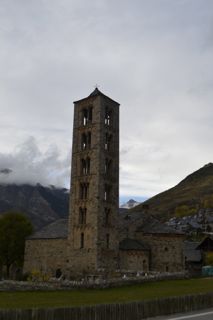Bravo Merlin. Drove him (her) today deep and high up into the Pyrennees. No trouble at all. Of course the speed would go down to 50 km/hour (30 mph) when there was an indication of climbing, but we knew that behaviour from even the tiniest hill in France. Hill or mountain, 50 is the maximum, but, as we found out, also the minimum speed.
Julie hinted she wanted to stay a little longer in sunny and warm (30-mid 80’s) Montblanc. But one has to be firm when one has a mission. Although there was quite a bit of medieval history in Montblanc, the 12th century passed by without lots of activity, at least not the kind of activity that still can be admired these days. Anyway, 30 degrees in november is bad for your character, so on we went.
We contemplated a few days about this stretch through the real Pyrennees. At the east part (that Julie passed last week next to the Mediterranean) and the west part (with the Atlantic Ocean) the Pyrennees flatten off and are easier on the engine. But I read about the beautiful Romanesq churches in the Valley of the river Boi. They are in the heart of the Pyrennees. But also worth the journey! Quite a unique Catalan interpretation of the first worldwide architectural style, as Romanesque is called in a tourism folder of this region.
Hoping that there would be no snow falling, we decided on this new adventure. On the way we passed the most amazing dry Spanish landscape I have ever seen. Lots of olive trees, of the dustiest green against a background of dusty yellowish and reddish soil. It makes one thirsty. But on and on we went, gradually climbing in ever higher hills. ‘Are these the Pyrennees’, Julie asked. ‘Not according to the map’, I answered. And then, suddenly, after turning one corner, there they were. Enormous walls of impassable cliffs, their tops in snow, hanging there as a curtain between Spain and France.
Breathtaking, but also nerve testing. ‘You’ll get a treat tonight’, Julie encouraged Merlin. He needed it. On we went. The amazing thing about curtains is that you can move them out of your way. And that is exactly what happened with the mountains. Our road found time after time a clever way to fool the mountains. It was like a game of tag (tikkertje) where the road was more clever than the mountain.
And so we arrived in Barruera, a village with one of the eight Romanesq Boi churches. Most of these churches are distinct by their high towers with, as in Burgundy, Lombard style characteristics; the hidden arches and the saw blade stone formations.
But it was closed, the church. Come to find out that we are visiting this area in the small strip of time in the year when mostly everything is closed, november being just between the summer season and the very lucrative winter and skiing season. Of the eight churches only two are opened. We went to see them today and it felt like seeing some friends of all time. The same intimacy, the charming features that we remembered, lovely statues, the whole works.
But they also looked pretty clean and almost too perfect. In the year 2000 these churches were recognized by unesco, which must have pumped in an enormous amount of money. There were even touch screen computers outside in four languages.
And then to think that this was just the poorest of poor areas, not even a generation ago. Lluís Domènech i Montaner, the architect from the magic Palau de Musica Catalana in Barcelona, discovered the churches in the beginning of last century. He helped preserve the amazingly well kept frescoes he discovered in these churches, ironically by removing them from the churches and installing them at the Catalan Museum in Barcelona, where Julie and Claire saw them last week. They had to do this because bloody Americans were buying the frescoes, and shipping them over. There must be one at the Boston Museum.
They became a cult place for Romanesque zealots. Till Unesco money (and ski-wealth) came and preserved these churches to a level where they look almost too well groomed. They are no real churches anymore. More like museums, as Julie mentioned. Form and function of church is a delicate matter, the more when the churches themselves become more special. The relationship, between form and function, was stretched in France, but here in Spain the original relationship has been broken. Most masses, of the not so many that take place, are in other, much less dignified buildings. It is the inflation of religion that has been going on for more than a century now.
Ah well. We had a good time with our old friends. The sun sank early behind the mountaintops. It is cold now, but the sky is clear, the air is healthy and it all makes us feel very much alive.
8 nov

Share


Claire says
Lovely written! Nice to read about the architect of Palau de la Musica and how he helped preserve fresco’s mom and I have seen. I miss Merlin!